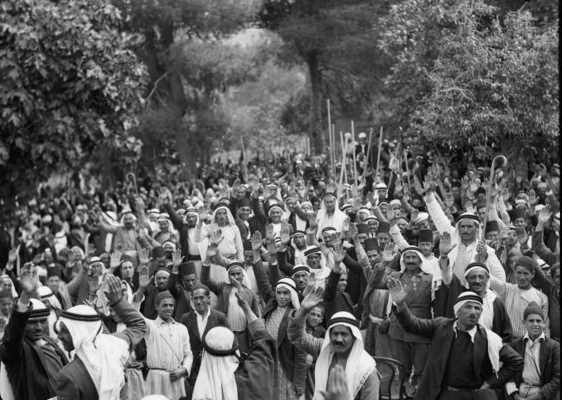Arab Immigration to the United States

By: Raisa Sami / Arab America Contributing Writer
Arab immigration to the United States has been marked by several distinct waves, each driven by unique socio-economic and political factors. The present article explores the four primary waves of Arab immigration to the United States, emphasizing the early economic migration that occurred in the late 19th and early 20th centuries, the mid-20th century brain drains, the political migrations that occurred in the 1970s, and the recent decades’ refugee influx.
Early Economic Migration: 1880s to 1920s
The 1880s and 1920s witnessed the first sizable wave of Arab immigrants to the United States. These early immigrants, who were mostly from what are now the countries of Lebanon, Syria, Palestine, and Jordan, were driven by a desire to leave the oppressive Ottoman Empire and by economic opportunities. Many were Christians from the Mount Lebanon region who were fleeing economic stagnation, political and religious persecution, and other hardships in search of a better life.
Because of the geopolitical nomenclature of the time, these early Arab immigrants were frequently referred to as “Syrians”. Usually, Ellis Island and other significant ports were the ports of entry into the United States. Many settled in urban centers such as New York, Boston, and Detroit, where they established vibrant communities. A significant number became peddlers, a common occupation that allowed them to traverse the country and eventually establish successful businesses. This period also saw the rise of Arab American entrepreneurs in the textile and garment industries, contributing to the economic fabric of their new homeland.
1948–1960s: The Brain Drain
The aftermath of World War II, the establishment of the state of Israel, and ensuing regional conflicts propelled the second wave of Arab immigration to the United States, which lasted from 1948 to the 1960s. During this time, there was a notable influx of highly educated professionals, such as doctors, engineers, and academics, which is commonly known as a “brain drain.
Many Palestinians were uprooted by the creation of Israel in 1948 and the Arab-Israeli conflict that followed; some of them sought safety in the United States. Skilled professionals who were keen to pursue security and career prospects overseas were also encouraged to migrate by the political unrest and economic instability in the larger Middle East. The intellectual and professional landscapes of these newly arrived educated immigrants’ new communities in the United States have been greatly influenced by them. During this period, there was a noticeable rise in the number of Arab scholars and students attending universities, especially in the sciences and engineering. Numerous of these people went on to make important contributions to their fields, demonstrating the rich intellectual and cultural exchange that exists between the Arab world and the United States.
Political Shift: The 1970s
Political unrest and violence throughout the Middle East played a major role in the 1970s third wave of Arab immigration. Many fled to the United States in search of safety and stability after significant events like the Lebanese Civil War (1975–1990), the aftermath of the 1967 Six-Day War, and numerous coups and political unrest in nations like Iraq, Egypt, and Syria. There were more political refugees and asylum seekers in this group than in previous waves of professional and economic migrants. Many were escaping political persecution and repression in addition to violence and instability. Due to its welcoming policies towards political refugees and its standing as a land of opportunity and freedom, the United States became a popular destination for these people.
The wave of immigrants contributed a wide range of political viewpoints and life experiences that enhanced the Arab American community’s cultural fabric. Many took an active role in community organizations and advocacy, which helped raise awareness of Middle Eastern issues in the larger American society.
Recent Waves: 1980s to Today
Due to large part to the ongoing conflicts in the Middle East, the most recent waves of Arab immigration from the 1980s to the present have been characterized by a combination of economic migration and refugee resettlement. These comprise the conflicts in the Gulf, Iraq, and Syria as well as other regional instability.
Economic Migration
Many Arabs have continued to immigrate to the US in search of economic opportunities despite the political unrest. Professionals seeking improved employment opportunities and business owners hoping to launch ventures in a more secure financial climate fall under this category. Particularly in the tech sector, a large number of highly qualified Arab professionals have arrived, adding to the sector’s diversity and inventiveness.
Refugee Influx
Recent immigration waves have included a sizable refugee component, especially in the wake of the wars in Syria and Iraq. Millions of people have been displaced by the Syrian Civil War alone, and many of them have applied for asylum in the US. Tens of thousands of Syrian refugees have been allowed into the country and have settled in different states, expanding the already large and diverse Arab American community.
Challenges and Contribution
These recent immigrants confront a variety of challenges, such as adjusting to a new language and culture and overcoming the trauma of displacement and conflict. They do, nevertheless, also contribute much in the ways of culture, society, and the economy. Arab American communities in the US are well-known for their lively cultural celebrations, prosperous enterprises, and engaged civic life. Arab immigrants have also encountered—and still do—a number of challenge, such as prejudice and xenophobia, especially in the years following 9/11. Notwithstanding these challenges, they have proven to be resilient and have significantly impacted the cultural and economic fabric of the US.
There have been four major waves of Arab immigration to the US, each with its own set of circumstances and driving forces. Every wave of immigration, from the economic migrants of the late 19th and early 20th centuries to the current wave of refugees escaping war, has contributed to the richness of the American cultural mosaic. The narrative of Arab American migration bears witness to the enduring allure of the American dream and the significant influence of varied cultures on the composition of American society as the country continues to grow as an immigrant nation.
Check out our Blog here!








